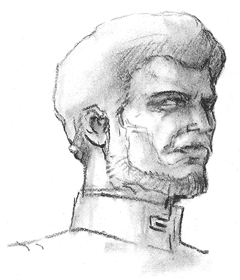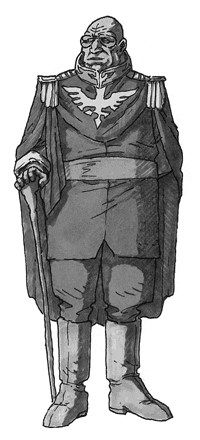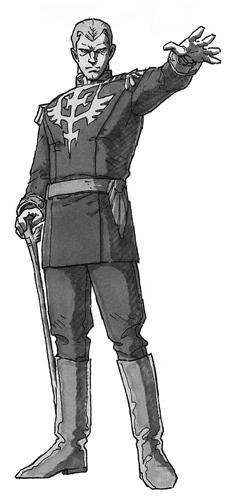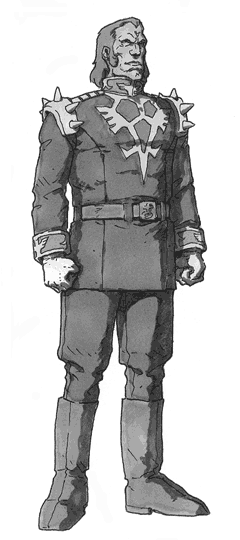
 Column Two:
Column Two:Old habits die hard for your humble author. Although I set up this new site to provide myself with a forum for purely self-indulgent ramblings, when I set about adding to it I find myself gravitating towards useful factual subjects. "Well, there's the whole space colonization thing, and the origins of the first mobile suits..." Let's see if I can cover both bases by using the helpful facts as a springboard for speculative trivia.
|
|
The root of the Gundam saga - or at least of the Universal Century history which accounts for the majority of the saga's installments - is the fierce struggle between Earth and its rebel space colonies known as the One Year War. Naturally, it didn't earn this name until it was actually over, and for the partisans this conflict is also known as the War Of Zeon Independence. Ironically, the Principality of Zeon entered the war already independent, and ended it as essentially a vassal state of the Earth Federation, so perhaps that name should be used advisedly...!
Ironies abound in considering the Principality of Zeon and its war against the Earth Federation. The scheming Zabi family waged a bitter power struggle against the visionary politician Zeon Zum Deikun, seized control of the republic he'd founded, and renamed the nation after their martyred adversary. They then launched a war to liberate the other space colonies from Federation tyranny, in which their opening gambit was murdering millions of innocent "spacenoids" with chemical and biological weapons. One might imagine this would cost the Principality the support of its fellow space colonists, were there any left to complain.
We now consider some of the eccentric personalities who helped create this rather mixed-up society...
 |
In U.C.0052 Deikun relocated to Side 3, a cluster of space colonies located behind the moon in the region known as Lagrange Point 2. Six years later this rabble-rousing leader declared Side 3 an independent republic. By most accounts this fledging nation was formally named the Republic of Zeon, after its founding prime minister, which suggests that the saintly Deikun may in fact have been something of an egomaniac. But if Deikun had only taken up residence at Side 3 a few years earlier, what was he doing before then?
This one isn't actually much of a mystery, since there's a documented answer (1). It seems that, before emigrating to Side 3, Deikun was a member of the Federation Assembly, and thus part of the terrestrial elite who governed the huddled masses of the space colonists. While his decision to give up his position and put his beliefs into practice out at the frontier was surely admirable, I can't help wondering if the arrival of this charismatic carpetbagger might have been resented by some of the colonies' homegrown leaders. Like, for instance...
 |
Degwin's history is a blank. He's said to have played a role in the internal politics of Side 3 since before Deikun's arrival (3), and his political and military maneuvers prevented the local Federation Forces garrison from suppressing Side 3's initial rebellion (4), but that's about all we know for sure. Also curious is the marked physical contrast between Degwin and his offspring: Garma's delicate features are inherited from his mother, but what about Dozle's and Gihren's hulking physiques? They're over six feet tall, with broad chests and thick necks, while their dad is a tiny old man who needs a cane to get around. Even for a 62-year-old, Degwin seems poorly preserved.
My theory? I suspect Degwin's been spending too much time on the moon. In the early days of the space colonization program, mining facilities were established on the lunar surface to furnish materials for colony construction (5). By U.C.0027 - when Degwin was ten years old - the first permanent lunar settlement, Von Braun City, had been established. Assuming that these lunar mining operations yielded profits even remotely proportional to the difficulty and danger of the work, an enterprising moon-mining mogul would be well-positioned to become a power broker in the newly established colony cluster parked in the moon's own back yard.
The downside of living and working on the moon for an extended period is, of course, the detrimental effect of low gravity. Bone and muscle loss, circulatory complications - it's simply not good for children and other living things. Barring advances in genetic engineering to address these problems, a man who would otherwise grow up to be a six-and-a-half-foot linebacker might well end up as a feeble runt after spending his formative years under one-sixth of Earth's gravity. The first generation of true space colonists, whose rotating habitats provide a full ration of healthy gravity, might well look at these stunted pioneers with a mixture of pity and contempt.
 |
We have just a few hints as to Gihren's background. Creator Yoshiyuki Tomino's Mobile Suit Gundam novels (6) explain how Zeon Deikun benefited from Degwin's and Gihren's backing, noting that in U.C.0065 Gihren's secret service purged thousands of Deikun opponents from Side 3 (7). Perhaps Gihren is alluding to this era when he reminds his father that "I was a participant in Zeon Deikun's revolution" (8). But whatever allegiance this fanatical dictator once had to the visionary Deikun is ancient history at this point, and Gihren has eschewed Deikun's woolly spiritualism in favor of a fascist vision of a space-born master race.
 |
Dozle's headquarters are at Solomon, the Space Strike Fleet's forward base, whose proximity to the battlefield provides ample opportunity for action-packed "frontline inspections." Located at Lagrange Point 5, next to Sides 1 and 4, this asteroid would have been inside Federation-controlled space until the outbreak of war. But given the swiftness with which it was put to use as a staging area for the Zeon forces (10), there clearly wasn't time for it to have been relocated from Zeon territory after the conflict began. Most likely Solomon was already in place - a resource asteroid, let's say, abandoned after the boom years of colony construction - and the Space Strike Fleet merely occupied it after carrying out their opening attacks on the neighboring Sides.
Then we have Dozle's distinctive scars, many of which were reputedly sustained during the violent power struggle that consumed Side 3 following Zeon Deikun's death, a conflict which also claimed the life of Degwin Zabi's second son Sasro (11). Some claim that it's because of Sasro's death that Dozle later shows such devotion to his brother Garma (12), but Dozle's affection for Garma more likely stems from the fact that - at least according to Tomino's novels - the two of them share the same mother. Apparently that's the exception, not the rule, in Degwin Zabi's household...
(1) Which appears in T2 Publishing's Zeon News - admittedly not the most definitive of sources, but I'll take what I can get.
(2) Specifically a heart attack, according to Char's comments in Mobile Suit Gundam III.
(3) Stampede, a comic biography of the famous Doctor Minovsky, shows Degwin personally recruiting this pioneering scientist for Side 3's scientific community in the early 0040s.
(4) So says the Sunrise-authorized tome imaginatively dubbed Gundam Officials.
(5) The electromagnetic mass drivers installed on the lunar surface, which were used to catapult minerals to colony construction sites, can be seen in later productions like Char's Counterattack.
(6) While their plot and characterization differ dramatically from the animated version, when it comes to background info and historical details which have yet to be covered in the animation, Tomino's novels are essentially the authority by default.
(7) A Gihren profile in volume 4 of Gundam Ace magazine sets this event a decade earlier, based on other historical references in the text of the novels, and then remarks on the precociousness of a twelve-year-old Gihren commanding the entire secret service. Your more skeptical author will stick with the U.C.0065 date cited in the novels, thank you very much.
(8) In the Mobile Suit Gundam III movie, which incorporates several references to the novels.
(9) Vice Admiral Killing J. Danningan, of the Space Strike Fleet's 2nd Division, is mentioned in the sketchy but enduringly popular Entertainment Bible 39: Strategy and Tactics Picture Encyclopedia, while Vice Admiral Randolph Weigelman commands the forces of A Baoa Qu in Tomino's novels.
(10) The aforementioned Entertainment Bible 39: Strategy and Tactics Picture Encyclopedia indicates that Solomon was the departure point for some of the Zeon forces which participated in the Battle of Loum, circa January 15, U.C.0079.
(11) Rapport's Mobile Suit Gundam Encyclopedia memorably depicts a wounded Dozle cradling the body of his slain kid brother Sasro in the aftermath of a car bombing. However, contrary to the Rapport editors' assumption, Sasro was actually Dozle's older brother, so the premise is unworkable.
(12) Rapport's Mobile Suit Gundam Encyclopedia again.
Mobile Suit Gundam is copyright © Sotsu • Sunrise. Everything else on this site, and all original text and pictures, are copyright Mark Simmons.